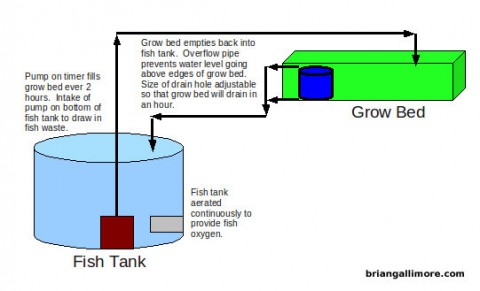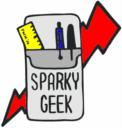 I’ve been talking about hydroponics and aquaponics for years now. (and now that I understand the biology a little more, I’m not even considering hydroponics anymore) I think it is time I finally implement my first solution. I’ll use this post to document what I want and where I’m going to get it from. (so it will change over time)
I’ve been talking about hydroponics and aquaponics for years now. (and now that I understand the biology a little more, I’m not even considering hydroponics anymore) I think it is time I finally implement my first solution. I’ll use this post to document what I want and where I’m going to get it from. (so it will change over time)
Style: Flood and Drain beds w/ gravel. Cold-water fish. Electric pump.
Tank: plastic stock tank. 110 gallon TSC SKU Number: 2229862
aquarium air pump w/ bubbler stone to oxygenate water all the time
submersible pond pump (eventually to be replaced with marine air conditioner pump), operated on an electrical cycle timer.
Grow Beds: made from 2by lumber, lined with pond plastic, filled with stone gravel (13mm) that doesn’t change pH. (crevices are desirable) Height: waist level. No auto-siphon is needed since I’m using a pump on a timer. Growbed Size: 4′ x 5′ x 12″ Red wiggler earthworms will be placed in the grow bed to further digest solid fish waste into plant nutrient. Sloped slightly. Min depth= 12 inches
water test kit – ammonia, nitrites, nitrates, oxygen, pH, temperature
Resources:
Blog entries and e-book from synaptoman
http://backyardaquaponics.com/
http://www.urbanaquaponics.com/
Multi-part how-to article from growing edge
Improved auto-siphon valve (Affnan’s bell valve)
from http://www.urbanaquaponics.com/content.php?129-Oxygen-Sizing-your-Aquaponic-Air-System:
- 1/2 lb of oxygen per lb of feed fed to fish (for home systems) (1lb oxygen / feed is safer)
- 23% of air is oxygen by weight (21% by volume) – 1 cubic foot of air weighs 0.075lbs
- efficiency of transferring oxygen into water is ~ .5 (standard)
system design tool http://www.aquaponic.com.au/backyard.htm
rules of thumb: http://theaquaponicsource.com/rules_of_thumb.php
- 1lb of fish per 5-7 gallons of water
- 1lb of fish for every 1 sq ft of grow bed surface (minimum 12″ depth)
- LECA (Lightweight Expanded Clay Aggregate, AKA Hydroton), Lava Rock, and Gravel are the most widely used media types. If you choose gravel, understand it’s source and avoid limestone and marble as they could affect your pH.
- cycle time: 15 minutes on, 45 minutes off
- flow the entire volume of fish tank through grow bed every hour (100 gallon tank will need a 400 GPH pump, adjusted for required lift)
- feed fish as much as they will eat in 5 minutes. (1% of body weight for adult, 7% for fry)
- add red worms to gravel after fish are established
- target pH is 6.8, to 7.0. test weekly
aeration rules of thumb: http://aquaponicscommunity.com/forum/topics/design-numbers
- 1 CFM (28 L/M)of air for each 400 gallons of fish tank
- need 1 psi to push air through the air stone
- need 1 psi to push air down 28 inches of water
http://www.growingedge.com/aquaponics-%E2%80%9Chow-to%E2%80%9D-part-2-grow-beds-and-fish-tanks
- start with a few fish to attract the bacteria — test daily – if too high, exchange 1/3 of the water with fresh de-chlorinated water.
- adjust pH by .2 per day maximum
- use product “pH Down” –sold at hydroponics stores
- to raise pH: alternate calcium hydroxide – also known as “hydrated lime” or “builder’s lime” with potassium carbonate (or bicarbonate) or potassium hydroxide (“pearlash” or “potash”). Don’t use citric acid as it is anti-bacterial!



More Links
Murray Hallam’s Practical Aquaponics Forum: http://www.aquaponics.net.au/forum/index.php
Aquaponics HQ Forum: http://www.aquaponicshq.com/forums/forum.php
Aquaponics in Paradise Forum: http://aquaponicsinparadise.com/APforums/
Backyard Aquaponics Forum: http://www.backyardaquaponics.com/forum/
DIY Aquaponics Forum: http://diyaquaponics.com/forum/portal.php
Urban Aquaponics Forum: http://www.urbanaquaponics.com/forum.php
2/21/2011 5pm:
-added 5 gallons of water from John D’s aquarium
pH = 8.0
Ammonia = 0.25ppm
Nitrite = 0ppm
Nitrate = 0ppm
added 2 teaspoons of pH down
added 12 oz of “Ammonia”
7pm:
pH = 7.8
Ammonia = 1.5ppm
2/23/2011 6pm:
pH= 7.6
Ammonia = 2 ppm
Nitrite = 0 ppm
Nitrate = 0 to 5 ppm
added 30 oz of ammonia
Ammonia = 4 ppm
Nitrite = 0 ppm
Nitrate = 5 ppm
costs of system components:
orders@theaquaponicsource.com
————————–
Product ID: ABAHF002
Product Name: MaxiCrop Liquid Seaweed – quart
Quantity: 1
Unit Price: $9.95
————————–
Product ID: CWHHF006
Product Name: ActiveAqua Pump 550 GPH
Quantity: 1
Unit Price: $44.95
————————–
Product ID: APPHF005
Product Name: Grounded Timer, 15 Min Cycle, 15 Amp, 24 Hour
Quantity: 1
Unit Price: $12.95
————————–
Product ID: APPHF001
Product Name: ActiveAqua Air Pump with 2 Outlets, 7.5L Per Minute
Quantity: 1
Unit Price: $10.95
————————–
Product ID: APPHF003E
Product Name: Air Stone, 6″ (15cm), 2 Pack
Quantity: 1
Unit Price: $3.95
————————–
Product ID: APPPM005
Product Name: Silicone Airline Tubing, 20 feet
Quantity: 1
Unit Price: $5.95
————————–
Product ID: ATSPW001
Product Name: API Freshwater Aquarium Test Kit
Quantity: 1
Unit Price: $21.95
————————–
Product ID: AWCPW002
Product Name: Aquarium Pharmaceuticals pH Down – 4 oz
Quantity: 1
Unit Price: $4.95
————————–
Product ID: ATSWG002
Product Name: Surfin Shark Thermometer
Quantity: 1
Unit Price: $9.95
————————–
Product ID: AASPW003
Product Name: Fish Net – JW Pet – Smartnet Fine – 10 Inch
Quantity: 1
Unit Price: $5.95
————————–
Order Total : $131.50
Shipping : $10.74
Grand Total : $142.24
110 gallon stock tank from Tractor Supply – $50 plus tax
Lumber, pipe, fittings, insulation. $200
Pond Liner – 45mil EPDM rubber, amazon.com $35
Gravel – native river rock from CSC in Plano $50
2/25/2011
pH = 7.6 or higher
ammonia = 4 ppm
nitrite = 0 ppm
nitrate = 5 ppm
added: 30oz of ammonia, 2 tsp of pH down, 10 caps of liquid seaweed
2/27/2011
pH = 7.6 or higher
ammonia = 8.0 ppm
nitrite = 0 pm
nitrate = 5 ppm
3/1/2011
pH = 7.6 or higher
ammonia = 8.0 ppm
nitrite = 0 ppm
nitrate = 5 ppm
added 4 tsp of pH down
3/5/2011
pH = 7.6 or higher
ammonia = 8.0 ppm
nitrite = 0.25 ppm
nitrate = 5 ppm
reading on the backyardaquaponics.com forum- they recommend you don’t try to adjust your pH down when the system is cycling. They have pH levels as high as 8.8, say they eventually come down naturally.
3/7/2011
ammonia = 8.0+
nitrite = 0.25
nitrate = 10
3/8/2011
added 5 caps of liquid fertilizer
3/9/2011
ammonia = 8.0+
nitrite = 0.5
nitrate = 10
3/12/2011
pH = 8.0
ammonia = 8.0+
nitrite = 0.5
nitrate = 10
3/13/2011
added 25 gallons of water, 10 caps of fertilizer
3/15/2011
pH = 8.2
ammonia = 8.0+
nitrite = 1.0
nitrate = 20
3/18/2011
pH = 8.2
ammonia = 8.0+
nitrite = 2.0
nitrate = 20
3/20/2011
pH = 8.2
ammonia = 8.0+
nitrite = 2.0
nitrate = 20
3/21/2011
added 20 tiny goldfish
added 20 red wigglers
pH = 8.0
ammonia = 8.0+ ppm
nitrite = 2 to 5 ppm
nitrate = 40 ppm
3/23/2011
1 dead fish
3/24/2011
1 dead fish
3/25/2011
added 10 large goldfish. (approx 6 to 8″ each)
pH = 8.0
ammonia = 4 ppm
nitrite = 5 ppm
nitrate = 80 ppm
3/26/2011
1 dead tiny goldfish (partially eaten)
added 25 gallons of water
added 2 plecostmus
added 2 algae eaters
pH = 7.4
ammonia = 1 ppm
nitrite = 5 ppm
nitrate = 80 ppm
added floating isolated bucket (1 qt) of duckweed
Brian, nice work documenting your aquaponics project. I’m in Fort Worth and am doing background reading prior to setting a system up in a largish backyard greenhouse (36/40′). Your blog has the highest concentration of guidelines and links I’ve seen anywere. Kudos.
Glad you found it useful Hal! I’d love to see pictures when you get started! (I’ll see them if you put them on backyardvegetablegardeners.com/forum)
Hi. Glad to find you. Am very interested in setting up an aquaponics system and have been trying to locate someone in Lubbock who might be up and going already. Would it be possible to see what you are doing? I’m a believer in learning from others who already have some experience. If that is a possibility please contact me.
Thanks,
Carol
I found some internet info on an operation in Wichita Falls Tx called Young’s Greenhouses. They operate an aquaponic system….largish one…and seem to have fabricated many of the components themselves. I will see if they would allow visitors.